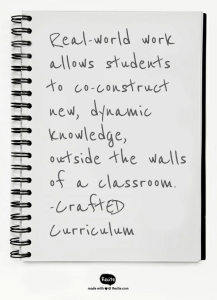This month we celebrate and encourage real-world work for adventurous teachers everywhere. If you are passionate about engaging your students, breaking outside the 4 walls of your classroom, and learning alongside your students, then read on!
CraftED Defines Real-World Work
It may be easiest to start with explaining first what real-world work isn’t. Real-world work is NOT your traditional field trip where students go to a location at the end of a unit or project, as a reward or celebration. Real-world work is NOT student bait and it is NOT a bonus experience that merely adds to the sexiness or excitement of learning standardized curriculum.
We define Real-world work as:
An experience tied directly to the current unit of study, whereby students are dependent upon gaining information and skills during a real-world work experience to complete their project/unit. The information that students gain from this experience could not be retrieved from any other source-meaning it will allow students to construct new, dynamic knowledge.
Real-world work could be any of the following:
- interviewing an expert (this can be done virtually if leaving school is not an option)
- shadowing an expert in the workplace
- observation/documentation of processes/human/animal behavior in a specific setting (livecams or google classroom can provide virtual alternatives)
- surveys
Making a Case for Real-world Work: Preparing Students for the 21st Century

One quick look at P21’s framework for 21st century learning and you will see a seamless alignment to the Deeper Learning Competencies and Common Core Standards. At CraftED we believe that real-world work is a way to get toward deeper learning by providing field-based context for content learned in the classroom, asking students to utilize critical thinking and oral communication skills on their feet, and ultimately apply their newfound knowledge to a larger, meaningful purpose. If we are going to prepare students to lead a future generation that is unknown to us, then we must ask them to begin constructing knowledge that does not exist in a textbook or on a worksheet. We must ask them NOW to begin innovating, and we must give them many opportunities to build these thinking muscles.
You can leverage real-world work as:
- A shared experience to draw upon later
- A form of data collection for research
- An opportunity for students to apply content to a new context; and
- A chance for students to practice skills, including working with peers, analysis, application and oral communication.
Teaching Tips
Real-world work can happen as early as kindergarten. Don’t believe me? Check out the work of this Kinder teacher on Twitter! Here are a couple of ways you can begin to think about integrating real-world work into your curriculum/classroom.
- Begin to brainstorm who may know more about something your students are learning (or want to learn more about) than you? Begin by asking your immediate community of parents and educators if they have any contacts.
- Is there place that your students could benefit from seeing with their own eyes? A place that could bring learning to life? How can you get your students to experience this?
- Are your students conducting research anytime soon? Where could they collect data, similar to how an expert in this field would?
Real-world work is a teaching strategy we are particularly passionate about at CraftED Curriculum. We can’t wait to share our teaching strategies and lessons on planning, facilitating and applying real-world work in the classroom on May 1st! Be sure to sign up for our mailing list on our website to be notified when our teaching materials go live! And if you haven’t already, join the growing CraftED Community on Twitter, Facebook and Pinterest.
